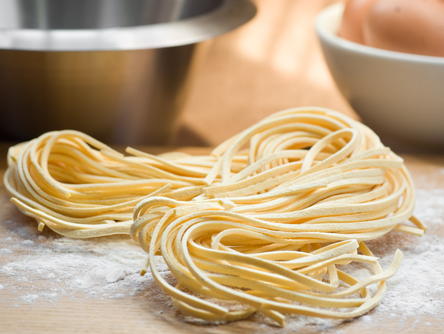Fresh Egg Pasta
MAKES: 4 servings
TIME: At least 1 hour, somewhat unattended
Egg pasta at its best; this Emiglia-Romagna-style pasta is rich and golden in color from the egg yolks. Because this recipe has a good amount of egg in it, the dough is moist and forgiving benefit if you’re a beginner.
About 2 cups all-purpose flour, plus more as needed
1 teaspoon salt
2 eggs
3 egg yolks
With a food processor: Combine the flour and salt in the container and pulse once or twice. Add the eggs and yolks all at once and turn the machine on. Process just until a ball begins to form, about 30 seconds. Add a few drops of water if the dough is dry and grainy; add a tablespoon of flour if the dough sticks to the side of the bowl.
By hand: Combine 11/2 cups of flour and the salt on a counter or large board. Make a well in the middle. Into this well, break the eggs and yolks. Beat the eggs with a fork, slowly and gradually incorporating a little of the flour at a time. When it becomes too hard to stir with the fork, use your hands. When all the flour has been mixed in, knead the dough, pushing it against the board and folding it repeatedly until it is not at all sticky and quite stiff.
Sprinkle the dough with a little of the reserved flour and cover with plastic or a cloth; let it rest for about 30 minutes. (You can store the dough in the refrigerator, wrapped in plastic, until you’re ready to roll it out, for up to 24 hours.)
Clamp a pasta machine to the counter; sprinkle your work surface lightly with flour. Cut off about one-third of the dough; wrap the rest in plastic or cloth while you work. Roll the dough lightly in the flour and use your hands to flatten it into a rectangle about the width of the machine. Set the machine to its highest (that is, thickest) setting and crank the dough through. If it sticks, dust it with a little more flour. Repeat. Set the machine to its next-thinnest setting and repeat. Each time, if the pasta sticks, sprinkle it with a little more flour and, each time, put the dough through the machine twice.
Continue to work your way down (or up, as the case may be each machine is numbered differently) through the numbers. If at any point the dough tears badly, bunch it together and start again (you will quickly get the hang of it). Use as much flour as you need to, but in small amounts each time.
Pass the dough through the machines thinnest setting, only once. (If this fails, pass it through the next-thinnest once.) Flour the dough lightly, cover it, and set it aside. Repeat the process with the remaining dough.
Cut each sheet into rectangles roughly 16 inches long and as wide as the machine; trim the ends to make it neat. Put it through the machine once more, this time using the broadest (tagliatelle) cutter. Or cut by hand into broad strips (pappardelle). Cook right away or hang the strands to dry for up to a couple of hours.
To cook the noodles, drop them into boiling salted water; they’ll be done when tender, in less than 3 (and probably less than 2) minutes. Sauce them immediately and serve.
Variation
Pizzocheri. A more robust, buckwheat pasta: Use 11/2 cups fine buckwheat flour and 1/2 cup all-purpose flour.








